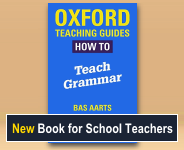Glossary: statement
Explanation
A label for the main use (or discourse function) of a declarative clause. For example, We danced all night is a declarative sentence which would typically be used as a statement. However, statements can also be used in different ways. For example, the following is an example of a sentence that has the structure of a statement, but is used as a question: You like fried bananas?. See also clause type, command, directive, question.
Englicious contains many resources for English language in schools, but the vast majority of them require you to register and log in first. For more information, see What is Englicious?

